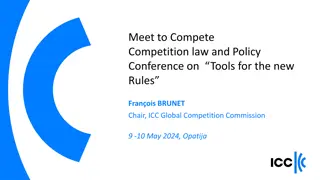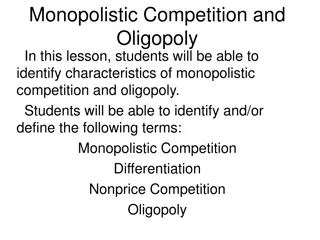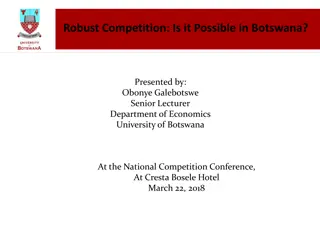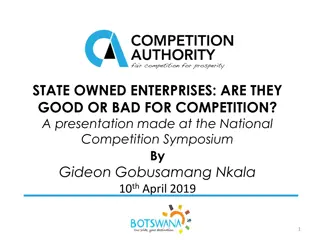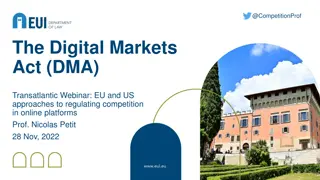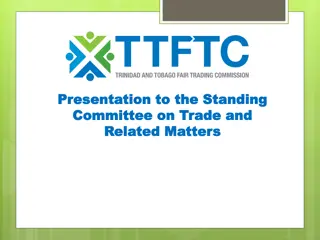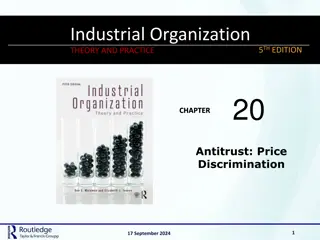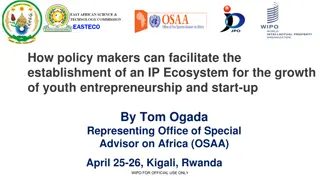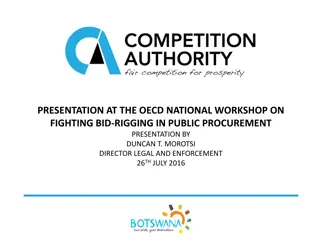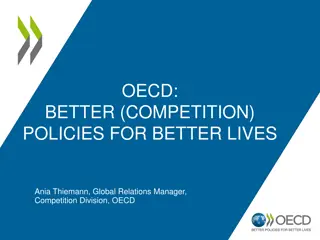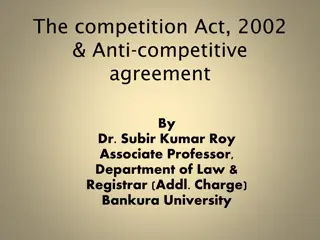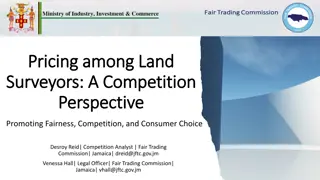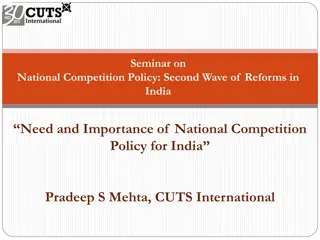
Mark-Ups in the Digital Era - Evidence for Competition Policy
The role of digital transformation in competitive dynamics, increased competition, winner-takes-most dynamics, and macro trends affecting mark-ups and concentration in the digital era.
Download Presentation

Please find below an Image/Link to download the presentation.
The content on the website is provided AS IS for your information and personal use only. It may not be sold, licensed, or shared on other websites without obtaining consent from the author. If you encounter any issues during the download, it is possible that the publisher has removed the file from their server.
You are allowed to download the files provided on this website for personal or commercial use, subject to the condition that they are used lawfully. All files are the property of their respective owners.
The content on the website is provided AS IS for your information and personal use only. It may not be sold, licensed, or shared on other websites without obtaining consent from the author.
E N D
Presentation Transcript
MARK-UPS IN THE DIGITAL ERA Sara Calligaris, Chiara Criscuolo, Luca Marcolin OECD TPRI Competition Conference 2018 What s the Evidence for Strengthening Competition Policy? Boston University School of Law July 23, 2018 The opinions expressed and arguments employed herein are solely those of the authors and do not necessarily reflect the official views of the OECD or of its member countries.
MOTIVATIONAND CONTRIBUTION DATA MARK-UP ESTIMATION FACTS MARK-UPSANDTHE DIGITAL TRANSFORMATION NEXT STEPSAND CONCLUSIONS
Motivation: the role of the digital transformation for competitive dynamics Digital technologies: lower costs of entry, operation, and experimentation; Ease sharing of ideas and innovation, network effect; Improve real-time measurement; Ease penetration of several markets and faster scaling up. These characteristics can potentially have different effects on the competitive environment: 1. Source of increased competition (Brynjolfsson et al., 2005); 2. Winner-takes-most dynamics (Brynjolfsson et al., 2008; Bessen, 2017). Moreover, increased importance of complementary investments in intangibles (Haskel and Westlake, 2017; Brynjolfsson and McElheran, 2016; Brynjolfsson et al., 2017).
Motivation: Macro trends Increase in mark-ups(De Loecker and Eeckhout, 2017; Traina, 2018; Andrews et al., 2018); Increase in concentration (Autor et al., 2017; Bessen, 2017; Gutierrez and Philippon 2016, 2017a,b; Grullon et al., 2017; But: Shapiro, 2017, Valletti et al., 2017); Declining business dynamism (e.g. Haltiwanger et al., 2017); Decline in both labour (Autor et al., 2017); and capital share (Barkai, 2016); Decline in investment intensities (Gutierrez and Philippon, 2016, 2017b). Increase in profit dispersion (MGI, 2015; Bessen, 2017; Eggertsson et al., 2018); Productivity slowdown and productivity divergence (Andrews, et al., 2017, Berlingieri et al., 2017);
Contribution 1. Identify patterns in the evolution of mark-ups across a large set of countries since the 2000s On average firm-level mark-ups have increased over time; The increase is mainly driven by in the top half of the mark-up distribution. 2. Link these changes to the digital transformation Mark-ups are higher in digital-intensive sectors, and more so now than at the beginning of the 2000s.
Contribution 3. Explore factors underlying the digital mark- up differential: Are higher mark-ups a reflection of the regulatory environment and global markets Product Market Regulation and international competition account only for part of these differences; Or are they a reflection of the Production Technology in digital intensive sectors? Intensity in intangible assets and innovation (firm level patenting) can explain almost half of the digital differential in mark-ups.
MOTIVATIONAND CONTRIBUTION DATA MARK-UP ESTIMATION FACTS MARK-UPSANDTHE DIGITAL TRANSFORMATION NEXT STEPSAND CONCLUSIONS
Firm Data: The OECD Matched Orbis- PatStat dataset Orbis firm-level dataset: 25 countries (AUS, AUT, BEL, BGR, DEU, DNK, ESP, EST, FIN, FRA, GBR, HUN, IDN, IND, IRL, ITA, JPN, KOR, LUX, NLD, PRT, ROU, SVN, SWE, USA); Period 2001-2014; Manufacturing and non-financial market services sectors. Only firms with more than 20 employees; Consolidated accounts. Final sample: approximately 2.5 mn. obs. Linked to all patent applications belonging to IP5 patent families, since 1985 from PatStat. Algorithmic matching, by company name (based on Squicciarini and Dernis, 2013). Indicators of interest: Stock of patents: sum of the depreciated patent count since the year of first filing of the first patent family. Depreciation = 15% (Hall et al., 2005). Citation-weighted stock of patents. Forward citation (5 years) as a proxy for technological and economic relevance of patent.
How do we define digital intensity? e-Commerce Labour-input indicators Market-related indicators ICT specialists Digital Investments in ICT equipment Purchase of ICT intermediate goods and services Robots intensity (manufacturing only) Investments in software Capital & intermediates indicators Computerised information (mostly) Official data: LFS, SNA, ICIO, ICT use survey; 36 sectors (ISIC4); 2001-15, balanced for 12 OECD countries; Global , cross-indicator, ranking is constructed as the weighted average of the rankings of sectors by each indicator; For details see Calvino, Criscuolo, Marcolin and Squicciarini (2018).
A taxonomy of digital intensive sectors Quartile of digital intensity: 2013-15 Low Medium-low Medium-high Medium-low Medium-low Medium-low Medium-low Medium-high Medium-high Medium-high High Medium-high Medium-high Low Low Medium-high High High High High High High Sector (ISIC rev.4) Food products, beverages and tobacco Textiles, wearing apparel, leather Wood and paper products, and printing Chemicals and chemical products Pharmaceutical products Rubber and plastics products Basic metals and fabricated metal products Computer, electronic and optical products Electrical equipment Machinery and equipment n.e.c. Transport equipment Furniture; other manufacturing; repairs of computers Wholesale and retail trade, repair Transportation and storage Accommodation and food service activities Publishing, audiovisual and broadcasting Telecommunications IT and other information services Legal and accounting activities, etc. Scientific research and development Advertising and market research; other business services Administrative and support service activities
MOTIVATIONAND CONTRIBUTION DATA MARK-UP ESTIMATION FACTS MARK-UPSANDTHE DIGITAL TRANSFORMATION NEXT STEPSAND CONCLUSIONS
Firm-level mark-ups Hall (1988) and De Loecker & Warzynski (2012): ???? ???? ???= . Intuition: in perfect competition input shares = output elasticities, Solow (1957). From firm s cost minimization problem with a fully flexible input intermediates. Specification: Cobb-Douglas and Translog 3-digit industry production function with 3 inputs. ACF algorithm, use of flexible polynomial, etc.
MOTIVATIONAND CONTRIBUTION DATA MARK-UP ESTIMATION FACTS MARK-UPSANDTHE DIGITAL TRANSFORMATION NEXT STEPSAND CONCLUSIONS
Facts 1 and 2: Rising mark-ups pushed by the top Translog Cobb-Douglas Deciles of the mark-up distribution in the year 2-digit sector (A38)averaged across sectors; Dynamics not due to a particular country.
MOTIVATIONAND CONTRIBUTION DATA MARK-UP ESTIMATION FACTS MARK-UPSANDTHE DIGITAL TRANSFORMATION NEXT STEPSAND CONCLUSIONS
Empirical framework Our estimating regression : ln(??,?,?,?)= ?0+ ?1???????,?+ ? ?,?,?,? ?? + ??,?+ ??,?,?,? (1) where: ???????,? is the Digital Intensity dummy (=1 if the sector is above median or in top quartile of the ranking); ? ?,?,? ?= {K intensity; Age; }; ??,? are country-year FE.
Fact 3: Mark-ups in digital vs. less digital intensive sectors Average percentage differences in mark-ups (digital vs less digital sectors) Pooled OLS estimation; Robust to Using Translog-mark-ups and TFP; Clustering errors at industry-country; excluding particular countries (e.g. US); Only surviving firms; Fixing digital at initial period.
What can explain ?1> 0 Market structure PMR: barriers to entry and barriers to investment (+); Globalization: Differential exposure to international competition (e.g. imports of intermediates) (+/-). Production technology High fixed cost and low marginal costs (+); Intensity in intangible investments (+); Role of innovation (+).
Regulatory impact (1) (2) (3) (4) 2001-2003 2013-2014 Digital-Intensive 0.119*** (0.002) -0.156*** (0.002) 0.076*** (0.006) 0.141*** (0.003) 0.109*** (0.002) -0.153*** (0.002) 0.083*** (0.006) 0.138*** (0.003) 0.303*** (0.010) 0.147*** (0.002) -0.163*** (0.002) 0.089*** (0.004) 0.153*** (0.002) 0.137*** (0.002) -0.161*** (0.002) 0.090*** (0.004) 0.151*** (0.002) 0.355*** (0.015) Log(age)(t-1) Log(K/Sales)(t-1) Log(tfp)(t-1) Regulatory impact Observations 207,958 0.092 207,958 0.103 170,686 0.153 170,686 0.159 R-squared Fixed Effects country-year country-year country-year country-year Cluster id id id id Note: Results of estimating OLS regressions. The Regulatory impact variable measures the impact of regulatory barriers to competition in non-manufacturing sectors on all industries, through intermediate inputs. Sectors are affected differently by the same regulation because they use products of the regulated sectors (intermediate inputs) to a different extent.
Intangible assets - OLS (1) (2) (3) (4) Digital-Intensive 0.064*** (0.002) -0.117*** (0.001) 0.149*** (0.003) 0.165*** (0.002) 0.045*** (0.002) -0.111*** (0.001) 0.155*** (0.003) 0.155*** (0.002) 0.034*** (0.001) 0.049*** (0.002) -0.112*** (0.001) 0.146*** (0.003) 0.159*** (0.002) 0.034*** (0.002) -0.113*** (0.001) 0.151*** (0.003) 0.159*** (0.002) Log(age)(t-1) Log(K/Sales)(t-1) Log(tfp)(t-1) Log(ICT specialists)(t-1) Log(ICT investment)(t-1) 0.050*** (0.002) Log(Software investment)(t-1) 0.026*** (0.001) Observations R-squared Fixed Effects Cluster 574,437 0.151 country-year id 574,437 0.169 country-year id 574,437 0.157 country-year id 574,437 0.158 country-year id Note: ICT specialists is the proportion of an industry s workforce employed in ICT-specialist occupations. ICT investment (resp. software) is the industry s volume of investment in ICT (resp. software) over the industry s volume of total non- residential investment.
Intangible assets - FE (1) (2) (3) (4) (5) (6) Log(age)(t-1) -0.018*** (0.001) 0.092*** (0.002) 0.009*** (0.001) -0.014*** (0.001) 0.089*** (0.002) 0.005*** (0.001) -0.014*** (0.001) 0.089*** (0.002) 0.005*** (0.001) -0.014*** (0.001) 0.089*** (0.002) 0.005*** (0.001) -0.014*** (0.001) 0.087*** (0.002) 0.006*** (0.001) -0.014*** (0.001) 0.089*** (0.002) 0.005*** (0.001) Log(K/Sales)(t-1) Log(tfp)(t-1) Log(ICT specialists)(t-1) 0.005 0.005 0.030*** (0.004) (0.004) (0.004) Log(ICT investment)(t-1) 0.004*** 0.004*** 0.004*** (0.001) (0.001) (0.001) Log(Software investment)(t-1) 0.008*** 0.007*** 0.007*** (0.001) (0.001) (0.001) Log(Stock Patents/Sales)(t-1) 0.019** 0.018** (0.008) (0.008) Observations R-squared Fixed Effects 574,437 0.955 574,437 0.954 574,437 0.954 574,437 0.954 574,437 0.954 574,437 0.954 country-year country-year country-year country-year country-year country-year Firm id Firm id Firm id Firm id Firm id Firm id Cluster Note: . Stock Patents is the stock of patents filed by the company in one of the IP5 Patent Offices during the considered period. ICT specialists is the proportion of an industry s workforce employed in ICT-specialist occupations. ICT investment (resp. software) is the industry s volume of investment in ICT (resp. software) over the industry s volume of total non- residential investment.
NEXT STEPS AND CONCLUSIONS
MOTIVATIONAND CONTRIBUTION DATA MARK-UP ESTIMATION FACTS MARK-UPSANDTHE DIGITAL TRANSFORMATION NEXT STEPSAND CONCLUSIONS
Extensions and future work Inclusion of SG&A as input; Go beyond ? (as high ?not necessarily market power) Look other measures of competitive dynamics: Concentration; EBITDA; Entry rates. Refine measures of market structure including international competition; Fixed cost intensity: Persistency of mark-ups over time. Role of reallocation vs within-firm dynamics ; Endogeneity of innovation.
Preliminary conclusions Average mark-ups are increasing over time, and driven by firms at the top of the mark-up distribution; Mark-ups higher in digital-intensive sectors than in less- digitally intensive sectors; Mark-up differentials have increased significantly over time; Market structure accounts for 8% (PMR) to 38% (import competition) of the digital dummy; Including intangibles and patents we can account for up to of the digital mark-ups differentials.
THANK YOU! sara.calligaris@oecd.org chiara.criscuolo@oecd.org luca.marcolin@oecd.org
Digital intensive sectors Balanced data for 36 sectors (ISIC4) in 12 OECD countries. Time series 2001-15. Multiple dimensions of the taxonomy: ICT investment intensity: deflated ICT tangible GFCF / total GFCF; Software investment intensity: deflated software GFCF / total GFCF; Robot intensity: Stock of robots / employment (manufacturing); Intermediates ICT goods and ICT services : deflated purchases of ICT intermediate goods (resp., services) / output; E-sales intensity: % of total sales carried out online; ICT specialists: # of ICT specialists in all countries / total employment. + Global ranking, across indicators (weighted average of the rankings of sectors by each indicator), for 2001-03 and 2013-15. See Calvino et al. (2018)
Supply-side approach to mark-ups Hall (1988) and De Loecker & Warzynski (2012): ??? ???? =???? ???? ???= , Mark-up corresponds to the ratio between: the elasticity of output with respect to intermediates (obtained by estimating a production function); and the cost of intermediates as a share of the firms revenue (observed in the data). We need to assume: Each firm is cost-minimising. One fully flexible input we use intermediates. Specification of the production function we use: industry-specific Cobb Douglas with 3 inputs (K, L, M). industry-specific Translog with 3 inputs (K, L, M).
Estimating OEs ????= first derivative of the log-production function w.r.t. intermediates. Here industry (3-digit ) production function with 3 inputs. If Cobb-Douglas (CD): y l = + + + + m k it l it m it k it it it Derivative: ??. Industry specific. If Translog (TL): y l m k = + + + + + + + lk it l k + + + 2 2 2 l m k l m m k it l it m it k it ll it mm it kk it lm it it it mk it it it it Derivative: ??+ 2 ?????+ ??????+ ??????. Firm specific. Intermediates as flexible input => Output-based production function => additional parameters => CD as baseline. Several other choices for estimation: ACF algorithm; use of 3- order polynomial and GMM to control for endogeneity, etc.
Mark-ups: demand- vs supply-side Supply-side Demand-side Advantages (1) Less micro data requirements AND relatively less demanding to estimate. (2) No need for information on product features. (3) No need to assume form of market conduct (FOC always valid). (3) controls for measurement error and endogeneity of inputs. (1) Still requires data to obtain TFP (and assumptions thereof if estimated). (2) Assume cost minimisation in all firms. (3) Assume at least one input is free to adjust. (1) No need to assume cost minimisation for all firms. (2) Estimation of demand systems, yielding direct estimate of market conduct / competition. Disadvantages (1) Need detailed product-level and consumer data. (2) Assume shape of utility function. (3) Assume way firms compete and set prices (e.g. Nash Bertrand). (4) IV needed to retrieve demand elasticities. Klette Berry (1994); BLP (1995); Goldberg (1995); Nevo (2000, 2001); Capps et al. (2003); Davis (2006); Zhelobodko et al. (2012); Berry and Haile (2015); Pakes (2015). Literature Hall (1988); Roeger (1995); Ellis and Halvorsen (2002); DeSouza (2009); De Loecker (2011); De Loecker and Warzynski (2012). De Loecker and Scott (2016): compare the approaches for one industry. The results indicate fairly broad agreement between the two approaches
Mark-ups: demand- vs supply-side Supply-side Demand-side Advantages (1) Less micro data requirements AND relatively less demanding to estimate. (2) No need for information on product features. (3) No need to assume form of market conduct (FOC always valid). (3) controls for measurement error and endogeneity of inputs. (1) Still requires data to obtain TFP (and assumptions thereof if estimated). (2) Assume cost minimisation in all firms. (3) Assume at least one input is free to adjust. (1) No need to assume cost minimisation for all firms. (2) Estimation of demand systems, yielding direct estimate of market conduct / competition. Disadvantages (1) Need detailed product-level and consumer data. (2) Assume shape of utility function. (3) Assume way firms compete and set prices (e.g. Nash Bertrand). (4) IV needed to retrieve demand elasticities. Klette Berry (1994); BLP (1995); Goldberg (1995); Nevo (2000, 2001); Capps et al. (2003); Davis (2006); Zhelobodko et al. (2012); Berry and Haile (2015); Pakes (2015). Literature Hall (1988); Roeger (1995); Ellis and Halvorsen (2002); DeSouza (2009); De Loecker (2011); De Loecker and Warzynski (2012). De Loecker and Scott (2016): compare the approaches for one industry. The results indicate fairly broad agreement between the two approaches
Descriptive statistics Summary statistics 2005 industry-level USD PPP, by digital intensity Variable Mean Median SD N. of obs. 51,100 11,800 401,000 2,285,584 Real Gross Output ( 000) 13,300 2,994 136,000 2,285,584 Real Value Added ( 000) 27,200 5,548 187,000 2,285,584 Real Intermediates ( 000) Number of employees 177 50 1,295 2,285,584 21,500 1,937 374,000 2,285,584 Real Capital Stock ( 000) Log(Mark-up): Cobb-Douglas 0.31 0.17 0.38 1,355,201 Log(Mark-up): Translog 0.16 0.07 0.25 1,753,176
Descriptive statistics (2) Summary statistics 2005 industry-level USD PPP, by digital intensity 2001-2003, less digital intensive Mean Median 32,200 9,050 9,200 2,651 15,800 3,862 134.4534 47 13,500 2,252 0.20 0.14 0.10 0.06 2013-2014, less digital intensive Mean Median 44,600 8,340 11,800 2,520 22,600 4,088 151.7968 50 26,700 2,451 0.25 0.17 0.12 0.07 2001-2003, digital intensive Median 12,400 2,891 6,106 189.6552 48 17,300 1,466 0.32 0.16 0.18 0.07 2013-2014, digital intensive Mean Median 69,700 14,300 17,900 3,552 37,700 7,059 217.8924 56 31,000 1,774 0.41 0.23 0.23 0.09 Diff. Variable SD N. Obs. 144,169 144,169 144,169 144,169 144,169 99,153 124,694 Mean 52,000 13,300 29,000 SD N. Obs. 234,190 234,190 234,190 234,190 234,190 131,128 172,126 250,000 98,800 125,000 1,475 166,000 0.21 0.14 405,000 147,000 212,000 1,366 470,000 0.40 0.26 *** *** *** *** *** *** *** Real Gross Output ( 000) Real Value Added ( 000) Real Intermediates ( 000) Number of employees Real Capital Stock ( 000) Log(Mark-up): Cobb-Douglas Log(Mark-up): Translog Variable SD N. Obs. 131,069 131,069 131,069 131,069 131,069 88,672 108,421 SD N. Obs. 217,299 217,299 217,299 217,299 217,299 118,830 156,149 537,000 202,000 225,000 1,464 567,000 0.28 0.17 531,000 169,000 263,000 1,449 485,000 0.48 0.31 *** *** *** *** *** *** *** Real Gross Output ( 000) Real Value Added ( 000) Real Intermediates ( 000) Number of employees Real Capital Stock ( 000) Log(Mark-up): Cobb-Douglas Log(Mark-up): Translog
Fact 4: rising mark-ups in digital more than less digital intensive sectors Note: The distinction between digital intensive sectors (resp. less digital intensive sectors) rank above (resp. below) the median sector by digital intensity. This graph fixes the ranking of sectors to the initial period (2001-03), and shows only mark-ups estimated assuming a Cobb-Douglas production function.
Fact 3: Mark-ups in digital vs. less digital intensive sectors (1) (2) (3) (4) (5) (6) (7) (8) 2001-2003 2013-14 Digital-Intensive 0.132*** (0.002) 0.118*** (0.002) 0.188*** (0.002) 0.151*** (0.002) Top-digital intensive 0.285*** (0.003) -0.042*** (0.001) 0.139*** (0.005) 0.269*** (0.002) -0.122*** (0.002) 0.102*** (0.006) 0.106*** (0.003) 0.475*** (0.003) -0.038*** (0.001) 0.093*** (0.003) 0.439*** (0.003) -0.096*** (0.001) 0.093*** (0.003) 0.084*** (0.002) Log(age)(t-1) -0.049*** (0.001) 0.106*** (0.006) -0.154*** (0.002) 0.058*** (0.006) 0.138*** (0.003) -0.058*** (0.001) 0.075*** (0.003) -0.154*** (0.002) 0.074*** (0.003) 0.141*** (0.002) Log(K/Sales)(t-1) Log(tfp)(t-1) Observations R-squared Fixed Effects 230,281 0.059 country- year id 230,281 0.090 country- year id 230,281 0.176 country- year id 230,281 0.193 country- year id 207,502 0.090 country- year id 207,502 0.147 country- year id 207,502 0.309 country- year id 207,502 0.328 country- year id Cluster Pooled OLS estimation Digital intensive sectors (above median) display higher Mark-ups. Difference between digital and less digital intensive sectors increased over time.
Fact 3: Mark-ups in digital vs. less digital intensive sectors (1) (2) (3) (4) (5) (6) (7) (8) 2001-2003 2013-14 Digital-Intensive 0.132*** (0.002) 0.118*** (0.002) 0.188*** (0.002) 0.151*** (0.002) Top-digital intensive 0.285*** (0.003) -0.042*** (0.001) 0.139*** (0.005) 0.269*** (0.002) -0.122*** (0.002) 0.102*** (0.006) 0.106*** (0.003) 0.475*** (0.003) -0.038*** (0.001) 0.093*** (0.003) 0.439*** (0.003) -0.096*** (0.001) 0.093*** (0.003) 0.084*** (0.002) Log(age)(t-1) -0.049*** (0.001) 0.106*** (0.006) -0.154*** (0.002) 0.058*** (0.006) 0.138*** (0.003) -0.058*** (0.001) 0.075*** (0.003) -0.154*** (0.002) 0.074*** (0.003) 0.141*** (0.002) Log(K/Sales)(t-1) Log(tfp)(t-1) Observations R-squared Fixed Effects 230,281 0.059 country- year id 230,281 0.090 country- year id 230,281 0.176 country- year id 230,281 0.193 country- year id 207,502 0.090 country- year id 207,502 0.147 country- year id 207,502 0.309 country- year id 207,502 0.328 country- year id Cluster Pooled OLS estimation Digital intensive sectors (above median) display higher Mark-ups. Difference between digital and less digital intensive sectors increased over time.
Manufacturing Vs. Services (1) (2) (3) (4) 2001-2003 2013-2014 Service Digital-Intensive 0.342*** (0.003) 0.155*** (0.002) -0.011*** (0.001) -0.028*** (0.001) 0.066*** (0.005) 0.325*** (0.003) 0.154*** (0.002) -0.013*** (0.001) -0.102*** (0.002) 0.033*** (0.006) 0.098*** (0.002) 0.370*** (0.003) 0.123*** (0.002) -0.035*** (0.002) -0.039*** (0.001) 0.051*** (0.003) 0.329*** (0.003) 0.121*** (0.002) -0.036*** (0.002) -0.114*** (0.002) 0.050*** (0.003) 0.108*** (0.002) Service Less-Digital Intensive Manufacturing Digital-Intensive Log(age)(t-1) Log(K/Sales)(t-1) Log(tfp)(t-1) Observations R-squared Fixed Effects Cluster 230,281 0.221 country-year id 230,281 0.236 country-year id 207,502 0.211 country-year id 207,502 0.243 country-year id
International competition in intermediates (1) (2) (3) (4) (5) Whole sample Manuf Services Whole sample Digital-Intensive 0.135*** (0.001) 0.086*** (0.001) -0.023*** (0.001) 0.138*** (0.003) Digital-intensive Service 0.235*** (0.003) 0.062*** (0.003) -0.027*** (0.001) -0.767*** Less-Digital Intensive Service Digital-intensive Manuf Log(Intermediates Import Intens) -1.954*** -0.219*** -2.577*** (0.015) -0.120*** (0.001) 0.016*** (0.003) 0.109*** (0.001) (0.015) -0.043*** (0.001) 0.068*** (0.004) 0.029*** (0.001) (0.124) -0.145*** (0.002) 0.034*** (0.004) 0.125*** (0.002) (0.022) -0.109*** (0.001) 0.033*** (0.003) 0.096*** (0.001) Log(age)(t-1) -0.149*** (0.001) 0.063*** (0.003) 0.128*** (0.001) Log(K/Sales)(t-1) Log(tfp)(t-1) Observations R-squared Fixed Effects Cluster 1,045,551 0.134 country-year id 1,045,551 0.209 country-year id 442,293 0.196 country-year id 603,258 0.149 country-year id 1,045,551 0.235 country-year id Note: Results of estimating OLS regressions. Log(intermediates import intens) is the logarithm of the ratio between a country- industry s imports of intermediates from the world and the country-industry s output. The ratio is available from 2005 onwards only.
International competition in intermediates (1) (2) (3) Whole sample Whole sample Digital-Intensive 0.135*** (0.001) 0.086*** (0.001) Digital-intensive Service 0.235*** (0.003) 0.062*** (0.003) -0.027*** (0.001) -0.767*** Less-Digital Intensive Service Digital-intensive Manuf Log(Intermediates Import Intens) -1.954*** (0.015) -0.120*** (0.001) 0.016*** (0.003) 0.109*** (0.001) (0.022) -0.109*** (0.001) 0.033*** (0.003) 0.096*** (0.001) Log(age)(t-1) -0.149*** (0.001) 0.063*** (0.003) 0.128*** (0.001) Log(K/Sales)(t-1) Log(tfp)(t-1) Observations R-squared Fixed Effects Cluster 1,045,551 0.134 country-year id 1,045,551 0.209 country-year id 1,045,551 0.235 country-year id Note: Results of estimating OLS regressions. Log(intermediates import intens) is the logarithm of the ratio between a country- industry s imports of intermediates from the world and the country-industry s output. The ratio is available from 2005 onwards only.
Different facets of the digital transformation (1) (2) (3) (4) (5) (6) Pooled OLS 0.134*** (0.002) -0.128*** (0.001) 0.098*** (0.003) 0.191*** (0.002) Digital-Intensive 0.084*** (0.002) -0.127*** (0.001) 0.107*** (0.003) 0.187*** (0.002) 0.033*** (0.001) 0.071*** (0.002) -0.121*** (0.001) 0.107*** (0.003) 0.178*** (0.002) 0.092*** (0.002) -0.123*** (0.001) 0.082*** (0.003) 0.185*** (0.002) 0.049*** (0.002) -0.112*** (0.001) 0.147*** (0.003) 0.159*** (0.002) 0.091*** (0.002) -0.134*** (0.001) 0.103*** (0.003) 0.196*** (0.002) Log(age)(t-1) Log(K/Sales)(t-1) Log(tfp)(t-1) Log(ICT specialists)(t-1) Log(ICT intermediate services)(t-1) 0.048*** (0.001) Log(ICT intermediate goods)(t-1) 0.010*** (0.001) Log(e-sales)(t-1) -0.062*** (0.001) Log(ICT investment) (t-1) 0.028*** (0.001) Log(Software investment)(t-1) 0.018*** (0.001) Observations R-squared Fixed Effects Cluster 905,471 0.191 Cou-year 840,107 0.199 Cou-year 750,006 0.193 Cou-year 752,605 0.194 Cou-year 578,443 0.157 Cou-year 737,545 0.184 Cou-year id id id id id id
Extensions and future work SGA expenses. Other correlates of mark-ups/measures of competitive dynamics: Concentration; Other proxies of international competition. Fixed cost intensity : EBITDA vs Mark-ups; Persistency of mark-ups over time; Within-Firm vs reallocation explanation Mark-ups at the productivity frontier and turbulence
Motivation: Market and Firm Dynamics trends in business dynamism business dynamism and digital transformation Contribution of young firms to aggregate productivity growth Productivity and wage divergence Productivity Slowdown Weight of largest firms What is happening to mark-ups? Trends in misallocation Changes in global production networks M&A dynamics in the era of digital change Declining labour share
Contribution Are the digitalisation and competitive dynamics linked? How? 1. We identify patterns in the evolution of mark-ups in the economy across a large set of countries 2. We link these changes be linked to the digital transformation 3. Investigate some underlying mechanisms Features of the market structure (international competition and market regulation); Firms innovation dynamics and importance of intangible capital.
Preview of the results 1. On average firm-level mark-ups have increased over time; 2. The increase is mainly driven by in the top half of the mark-up distribution; 3. Mark-ups are higher in digital-intensive sectors, and more so now than at the beginning of the 2000s; 4. Product market regulation and international competition account only for part of these differences; 5. A large part of the mark-up differential in digital sectors can be explained by higher intensity in intangible assets.
Fact 1: Rising mark-ups Cobb-Douglas Translog Note: Unconditional averages of firm-level log mark-ups. The figure plots log-mark-ups and indexes the 2001 level to 0, hence the vertical axes represent log-differences from the starting year which, given the magnitudes, approximates well for growth rates.



